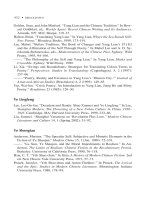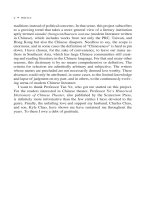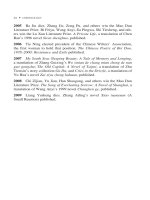historical dictionary of sweden
Bạn đang xem bản rút gọn của tài liệu. Xem và tải ngay bản đầy đủ của tài liệu tại đây (9.06 MB, 368 trang )
SCOBBIE
SECOND
EDITION
EUROPE HISTORY
HISTORICAL DICTIONARIES OF EUROPE, NO. 48
Praise for the first edition:
“Recommended for most academic libraries . . . a quick reference tool to those
who need some general information or an overview.”
—
ARBA
“A useful historical dictionary with a very good bibliography.”
—
Area Studies
“A satisfactory English-language summary of Swedish history, with good
thumbnail sketches of important figures and events.”
—
Journal of Baltic Studies
Once part of the Kalmar Union—along with Denmark and Norway—the
Kingdom of Sweden broke free in order to govern itself in the early 1500s, and
for more than a century afterward it was a force to be reckoned with. At its
peak it was twice the size it is today, but with the secession of Finland in 1809
and the rise of Russia, Sweden changed its path and turned toward neutrality
and a peaceful existence. Today, Sweden boasts a healthy economy and is an
important member of the European Union, as well as a major contributor to
international activities.
This second edition of
Historical Dictionary of Sweden
both updates and
expands upon the previous edition. Through a chronology, a list of acronyms
and abbreviations, an introductory essay, a bibliography, appendixes, and
hundreds of cross-referenced dictionary entries on significant people, events,
and institutions, this dictionary provides information ranging from politics to
economics, education to religion, and music to literature.
Irene Scobbie has written extensively on Sweden and lectured on Sweden and
Scandinavia at several universities, including the University of Edinburgh,
where she was head of the Department of Scandinavian Studies before retiring.
For orders and information please contact the publisher
SCARECROW PRESS, INC.
A wholly owned subsidiary of
The Rowman & Littlefield Publishing Group, Inc.
4501 Forbes Boulevard, Suite 200
Lanham, Maryland 20706
1-800-462-6420 • fax 717-794-3803
www.scarecrowpress.com
ISBN-13: 978-0-8108-5375-1
ISBN-10: 0-8108-5375-2
9 780810 853751
90000
IRENE SCOBBIE
sweden
SECOND EDITION
Historical Dictionary of
sweden
HDSwedenOFFLITH.qxd 7/25/06 11:42 AM Page 1
HISTORICAL DICTIONARIES OF EUROPE
Edited by Jon Woronoff
1. Portugal, by Douglas L. Wheeler. 1993. Out of print. See No. 40.
2. Turkey, by Metin Heper. 1994. Out of print. See No. 38.
3. Poland, by George Sanford and Adriana Gozdecka-Sanford. 1994.
Out of print. See No. 41.
4. Germany, by Wayne C. Thompson, Susan L. Thompson, and
Juliet S. Thompson. 1994
5. Greece, by Thanos M. Veremis and Mark Dragoumis. 1995
6. Cyprus, by Stavros Panteli. 1995
7. Sweden, by Irene Scobbie. 1995. Out of print. See No. 48.
8. Finland, by George Maude. 1995. Out of print. See No. 49.
9. Croatia, by Robert Stallaerts and Jeannine Laurens. 1995. Out of
print. See No. 39.
10. Malta, by Warren G. Berg. 1995
11. Spain, by Angel Smith. 1996
12. Albania, by Raymond Hutchings. 1996. Out of print. See No. 42.
13. Slovenia, by Leopoldina Plut-Pregelj and Carole Rogel. 1996
14. Luxembourg, by Harry C. Barteau. 1996
15. Romania, by Kurt W. Treptow and Marcel Popa. 1996
16. Bulgaria, by Raymond Detrez. 1997. Out of print. See No. 46.
17. United Kingdom: Volume 1, England and the United Kingdom;
Volume 2, Scotland, Wales, and Northern Ireland, by Kenneth J.
Panton and Keith A. Cowlard. 1997; 1998
18. Hungary, by Steven Béla Várdy. 1997
19. Latvia, by Andrejs Plakans. 1997
20. Ireland, by Colin Thomas and Avril Thomas. 1997
21. Lithuania, by Saulius Suziedelis. 1997
22. Macedonia, by Valentina Georgieva and Sasha Konechni. 1998
23. The Czech State, by Jiri Hochman. 1998
24. Iceland, by Gu∂mundur Hálfdanarson. 1997
25. Bosnia and Herzegovina, by Ante Cuvalo. 1997
26. Russia, by Boris Raymond and Paul Duffy. 1998
27. Gypsies (Romanies), by Donald Kenrick. 1998
28. Belarus, by Jan Zaprudnik. 1998
29. Federal Republic of Yugoslavia
, by Zeljan Suster. 1999
30. F
rance, by Gino Raymond. 1998
06-340_01_Front.qxd 7/27/06 11:14 AM Page i
31. Slovakia, by Stanislav J. Kirschbaum. 1998. Out of print.
See No. 47.
32. Netherlands, by Arend H. Huussen Jr. 1998
33. Denmark, by Alastair H. Thomas and Stewart P. Oakley. 1998
34. Modern Italy, by Mark F. Gilbert and K. Robert Nilsson. 1998
35. Belgium, by Robert Stallaerts. 1999
36. Austria, by Paula Sutter Fichtner. 1999
37. Republic of Moldova, by Andrei Brezianu. 2000
38. Turkey, 2nd edition, by Metin Heper. 2002
39. Republic of Croatia, 2nd edition, by Robert Stallaerts. 2003
40. Portugal, 2nd edition, by Douglas L. Wheeler. 2002
41. Poland, 2nd edition, by George Sanford. 2003
42. Albania, New edition, by Robert Elsie. 2004
43. Estonia, by Toivo Miljan. 2004
44. Kosova, by Robert Elsie. 2004
45. Ukraine, by Zenon E. Kohut, Bohdan Y. Nebesio, and Myroslav
Yurkevich. 2005
46. Bulgaria, 2nd edition, by Raymond Detrez. 2006
47. Slovakia, 2nd edition, by Stanislav J. Kirschbaum. 2006
48. Sweden, 2nd edition, by Irene Scobbie. 2006
49. Finland, 2nd edition, by George Maude, 2007
06-340_01_Front.qxd 7/27/06 11:14 AM Page ii
Historical Dictionary
of Sweden
Second Edition
Irene Scobbie
Historical Dictionaries of Europe, No. 48
The Scarecrow Press, Inc.
Lanham, Maryland • Toronto • Oxford
2006
06-340_01_Front.qxd 7/27/06 11:14 AM Page iii
SCARECROW PRESS, INC.
Published in the United States of America
by Scarecrow Press, Inc.
A wholly owned subsidiary of
The Rowman & Littlefield Publishing Group, Inc.
4501 Forbes Boulevard, Suite 200, Lanham, Maryland 20706
www.scarecrowpress.com
PO Box 317
Oxford
OX2 9RU, UK
Copyright © 2006 by Irene Scobbie
All rights reserved. No part of this publication may be reproduced, stored in a
retrieval system, or transmitted in any form or by any means, electronic,
mechanical, photocopying, recording, or otherwise, without the prior permission of
the publisher.
British Library Cataloguing in Publication Information Available
Library of Congress Cataloging-in-Publication Data
Scobbie, Irene.
Historical dictionary of Sweden / Irene Scobbie. — 2nd ed.
p. cm. — (Historical dictionaries of Europe ; no. 48)
Includes bibliographical references.
ISBN-13: 978-0-8108-5375-1 (hardcover : alk. paper)
ISBN-10: 0-8108-5375-2 (hardcover : alk. paper)
1. Sweden—History—Dictionaries. I. Title. II. Series.
DL643.S37 2006
948.5003—dc22 2006013958
ϱ
™
The paper used in this publication meets the minimum requirements of
American National Standard for Information Sciences—Permanence of Paper
for Printed Library Materials, ANSI/NISO Z39.48-1992.
Manufactured in the United States of America.
06-340_01_Front.qxd 7/27/06 11:14 AM Page iv
Contents
v
Editor’s Foreword Jon Woronoff vii
Acknowledgments ix
Reader’s Note xi
List of Acronyms and Abbreviations xiii
Map xv
Chronology xvii
Introduction xxvii
THE DICTIONARY 1
Appendix A: Swedish Rulers 263
Appendix B: Swedish Prime Ministers 265
Appendix C: Sweden’s 25 Largest Companies 267
Selected Bibliography 269
About the Author 317
06-340_01_Front.qxd 7/27/06 11:14 AM Page v
06-340_01_Front.qxd 7/27/06 11:14 AM Page vi
Editor’s Foreword
vii
Just like people, countries change. This applies most emphatically to
Sweden. Once warlike and expansive, it has become neutral and if any-
thing contented with its lot. Once terribly poor and backward, it has be-
come uncommonly rich and advanced. Once conservative and domi-
nated by the nobility and men in general, it has become a prolific source
of social experiments with particular stress on equality. This has put
Sweden in the forefront in many sectors, indeed, so much so that the
Swedish “miracle” was widely admired and emulated. Yet, even now
that the limitations and failings are more evident, it remains a country
from which much can be learned.
These changes obviously took decades and sometimes centuries, so
they can only be correctly appreciated by observing the longer trends.
That is just one reason why this Historical Dictionary of Sweden is so
useful. And it is even more useful in its second updated and greatly ex-
panded edition. For, it does take a long view, and it does show us where
Sweden is coming from. But it also looks very carefully at the present
situation, the problems as well as the achievements. The entries thus
cover kings and nobles but also politicians, economists, businessmen,
scientists, and cultural figures. Others describe the major institutions,
political parties, trade unions, and newspapers or the educational system
and literature. The flow of events can be grasped more readily thanks to
a handy chronology. Those wanting to learn more about any particular
aspect can consult a substantial and well-structured bibliography.
This new edition, like the first edition, was written by someone who
has devoted much of her life, initially, to learning about Sweden and
then to teaching about Sweden, Irene Scobbie. The learning was at Uni-
versity of Newcastle, at University College London, and also in Swe-
den. The teaching was, among other places, at the University of Cam-
bridge; the University of Aberdeen, where she became the head of the
06-340_01_Front.qxd 7/27/06 11:14 AM Page vii
Department of Scandinavian Studies; and finally the University of Ed-
inburgh, where she also held that post. Before this book, she also wrote
a general work, Sweden: Nation of the Modern World, and numerous ar-
ticles, monographs, and chapters on Sweden and especially Swedish lit-
erature. In 1985 she was awarded the Swedish Polar Star (1st Class) for
service to Swedish culture.
Jon Woronoff
Series Editor
viii • EDITOR’S FOREWORD
06-340_01_Front.qxd 7/27/06 11:14 AM Page viii
Acknowledgments
ix
I am greatly indebted to Per Clemensson and his colleagues at Riks-
föreningen Sverigekontakt for a grant toward research and travel ex-
penses incurred during the preparation of this revised edition of the His-
torical Dictionary of Sweden.
I thank Jon Woronoff, the series editor, who read the completed man-
uscript and made many valuable comments.
I express my gratitude to several Gothenburg friends, especially Dr.
Maj-Lis Häggkvist, Dr. Monika Tunbäck Hansson, and above all fil.
mag. Barbro Lindberg, for their expert advice, generous assistance,
and encouragement in the production of this volume. Final responsi-
bility for the text rests, of course, solely with the author.
06-340_01_Front.qxd 7/27/06 11:14 AM Page ix
06-340_01_Front.qxd 7/27/06 11:14 AM Page x
Reader’s Note
xi
The Swedish alphabet has three extra characters—å, ä, and ö—which
come at the end of the alphabet. Here they are treated as if unmodified
and are placed alphabetically as a, a, and o, respectively.
Swedish proper names have been used for the most part in this vol-
ume (e.g., Karl XII for Charles XII, Skåne for Scania), but there a few
exceptions (e.g., Gothenburg instead of Göteborg) where the English
version is much more familiar than the Swedish.
The Swedish parliament is the Riksdag, a term used throughout this
volume.
06-340_01_Front.qxd 7/27/06 11:14 AM Page xi
06-340_01_Front.qxd 7/27/06 11:14 AM Page xii
Acronyms and Abbreviations
xiii
AB Aktiebolag (Limited Company)
ABF Arbetarnas Bildningsförbund (Workers’ Educational
Association)
AMS Arbetsmarknadsstyrelsen (Labor Market Board)
APK Arbetarpartiet Kommnunisterna (Workers’ Communist
Party)
ASEA Allmänna Svenska Elektriska Aktiebolaget
ATP Allmän Tilläggspension (general supplementary pension)
DN Dagens Nyheter (Daily News)
EC European Community
EEC European Economic Community
EFTA European Free Trade Association
EU European Union
GDP Gross Domestic Product
HSB Hyresgästernas Sparkasse- och Byggnadsförening (Tenants’
Savings and Building Society)
IOGT International Order of Good Templars
IT Information Technology
JO Justitieombudsman
KB Kungliga Biblioteket (Royal Library)
KDP Kristdemokraterna (Christian Democratic Party)
KF Kooperativa Förbundet (Cooperative Union)
LKAB Luossavaara-Kiirunavaara AB
LO Landsorganisationen (Swedish Confederation of Trade
Unions)
LRF Lantbrukarnas Riksförbund (Federation of Swedish
Farmers)
NATO North Atlantic Treaty Organization
NSF Nationalsocialistisk Front (National Socialist Front)
06-340_01_Front.qxd 7/27/06 11:14 AM Page xiii
NU Nationell Ungdom (National Youth)
OECD Organization for Economic Cooperation and Development
OEEC Organization for European Economic Cooperation
OPEC Organization of Petroleum Exporting Countries
SAC Sveriges Arbetares Centralorganisation (Swedish Workers’
Central Organization)
SACO Sveriges Akademikers Centralorganisation (Swedish
Central Organization of Professional Workers)
SAF Svenska Arbetsgivareföreningen (Swedish Federation of
Employers)
SÄPO Svenska Säkerhetspolisen (Swedish Security Police)
SAS Scandinavian Airlines System
SEK Swedish krona
SHT Göteborgs Handels- och Sjöfarts Tidning
SKF Svenska Kullagerfabriken (Swedish Ball Bearing
Company)
SMR Svenska Motståndsrörelsen (Swedish Opposition
Movement)
SR Statstjänstemännens Riksförbund (National Association of
Swedish State Employees)
SR Sveriges Radio (Sweden’s Radio)
SRK Svenska Röda Korsets (Swedish Red Cross)
SSU Sveriges Socialdemokratiska Ungdomsförbundet (Swedish
Young Social Democrats)
STF Svenska Turistföreningen (Swedish Tourist Association)
SUNS Stockholms Unga Nationalsocialister (Stockholm Young
National Socialists)
SvD Svenska Dagbladet
SVT Sveriges Television (Sweden’s Television)
TCO Tjänstemännens Centralorganisation (Central Organization
of Salaried Employees)
UN United Nations
USSR Union of Soviet Socialist Republics
VAM Vitt Ariskt Motstånd (White Arian Opposition)
WEF Wage Earner Funds
xiv • ACRONYMS AND ABBREVIATIONS
06-340_01_Front.qxd 7/27/06 11:14 AM Page xiv
06-340_01_Front.qxd 7/27/06 11:14 AM Page xv
06-340_01_Front.qxd 7/27/06 11:14 AM Page xvi
Chronology
xvii
c. 12,000 B.C. Nomadic tribes of reindeer hunters enter Sweden.
c. 12,000–1500
B.C. Stone Age
c. 2500
B.C. New tribes introduce agriculture and husbandry. Dolmens
raised in western Sweden.
c. 2000
B.C. Boat-Ax People’s culture begins to spread in southern
and central areas.
c. 1500–500
B.C. Bronze Age. Rich burial mounds and rock carvings
on west coast.
c. 400
B.C.–A.D. 1 Early Iron Age. Iron used for tools and weapons.
c.
A.D. 1–400 Roman Iron Age. Trade links with Romans established.
98 Tacitus mentions the Suiones in his Germania.
c. 400–800 Later Iron Age. Svear gain supremacy over Götar.
c. 800–1060 Viking Age. Swedish Vikings travel east and south to
Russia, the Caspian Sea, and the Black Sea.
829 Missionary Ansgar visits Birka.
1008 King Olof Skötkonung baptized.
1080 King Inge driven from Uppsala for refusing to perform pagan
rites.
1130s Christian church built on site of Uppsala pagan temple.
1160 Death of Erik (later Saint Erik).
1164 (Old) Uppsala archbishopric established.
06-340_01_Front.qxd 7/27/06 11:14 AM Page xvii
1187 Pirates sack Sigtuna.
1266 Death of Birger Jarl.
1303 Birgitta Birgersdotter (Saint Birgitta) born at Finsta.
1313–64 Reign of King Magnus Eriksson.
1323 Peace of Nöteborg establishes frontiers between Russia and
Sweden-Finland.
c. 1350 National law code introduced.
1364–1389 Reign of King Albrekt of Mecklenburg.
1397 Kalmar Union under Erik of Pomerania.
1412 Death of Queen Margareta.
1434 Engelbrekt Engelbrektsson’s revolt.
1470 Sten Sture the Elder elected regent.
1471 Sten Sture victorious at Battle of Brunkeberg.
1477 Uppsala University founded.
1512–1520 Regency of Sten Sture the Younger.
1520 Stockholm Bloodbath.
1523–1560 Reign of King Gustav I Vasa.
1527 Catholic Church property transferred to the Crown. Lutheranism
introduced.
1541 Bible published in Swedish (Gustav Vasa Bible).
1560–1568 Reign of King Erik XIV.
1563–1570 Northern Seven Years War.
1568 Johan III deposes Erik XIV.
1592–1599 Reign of King Sigismund in Sweden.
1599 Duke Karl becomes regent.
1603–1611 Reign of King Karl IX.
xviii • CHRONOLOGY
06-340_01_Front.qxd 7/27/06 11:14 AM Page xviii
1611–1632 Reign of King Gustav II Adolf.
1611–1718 Age of Greatness.
1617 Peace of Stolbova. Ingria and Southwest Karelia ceded to Swe-
den.
1621 City of Gothenburg granted its charter.
1626 House of Nobility Ordinance.
1632 Colony of New Sweden established on the Delaware River in
North America.
1632–1654 Reign of Queen Kristina.
1654–1660 Reign of King Karl X Gustav.
1658 Peace of Roskilde; Denmark cedes southern provinces to Swe-
den.
1660–1697 Reign of King Karl XI.
1668 Lund University inaugurated.
1676 Battle of Lund.
1693 Declaration of Sovereignty, giving Karl XI absolute power.
1697–1718 Reign of King Karl XII.
1700 Battle of Narva; Swedes defeat Russian tsar’s army.
1709 Karl’s army routed at Battle of Poltava.
1718 Karl killed at Fredriksten; end of Great Northern War.
1718–1772 Age of Liberty.
1719 Ulrika Eleonora, Karl XII’s sister, elected queen of Sweden.
1720–1751 Reign of Fredrik I, Ulrika Eleonora’s consort.
1731 Swedish East India Company set up.
1735 Carolus Linnaeus publishes Systema naturae.
1738 Arvid Horn resigns chancellorship; Hat Party in office.
CHRONOLOGY • xix
06-340_01_Front.qxd 7/27/06 11:14 AM Page xix
1739 Swedish Royal Academy of Sciences founded.
1741 Unsuccessful war against Russia.
1751–1771 Reign of King Adolf Fredrik and his consort Lovisa Ul-
rika.
1756 Court Party’s abortive coup.
1756–1763 Seven Years’ (Pomeranian) War.
1757 Land reform (Storskifte).
1765–1772 Cap Party in office.
1771–1792 Reign of King Gustav III.
1772 Gustav stages coup and introduces a new constitution, ending
Age of Liberty.
1772–1809 Gustavian Age.
1782 Gustav III establishes Royal Opera House.
1783 Rutger Maclean introduces land enclosures (enskifte) on his estate.
1786 Gustav III founds Swedish Academy.
1788–1790 War with Russia. Anjala League approaches Catherine the
Great.
1789 Act of Union and Security gives Gustav III almost absolute
power.
1792 Gustav III assassinated at masked ball.
1792–1809 Reign of King Gustav IV Adolf.
1808 War against Russia, France, and Denmark.
1809 King Gustav IV Adolf deposed and a new constitution enacted.
Sweden loses Finland and Åland in Peace of Fredrikshamn.
1809–1818 Reign of King Karl XIII.
1810 Jean-Baptiste Bernadotte elected crown prince.
xx • CHRONOLOGY
06-340_01_Front.qxd 7/27/06 11:14 AM Page xx
1812 Karl Johan’s (Bernadotte’s) “1812 policy” supports Tsar
Alexander against Napoleon in exchange for Russian support in gaining
Norway.
1814 In Peace of Kiel, Denmark cedes Norway. Norway Assembly
accepts new constitution. Moss Convention; Norway accepts union
with Sweden under Karl XIII.
1818–1844 Reign of King Karl XIV Johan in Norway and Sweden.
1830 Lars Johan Hierta launches Aftonbladet.
1832 Göta Canal completed.
1837 Swedish Abstinence Society founded.
1842 Education Act makes primary education compulsory.
1844–1859 Reign of King Oscar I in Norway and Sweden.
1846 Guilds abolished and trade restrictions lifted.
1848 February Revolution has repercussions in Sweden in form of
street riots. Per Götrek publishes the Communist Manifesto in Swedish.
1851 Swedish Order of Good Templars founded.
1853 Decision that state will build mainline railroads made. Sweden’s
first telegraph line between Stockholm and Uppsala installed.
1855 In November Treaty, Britain and France guarantee protection
against Russia.
1859–1872 Reign of King Karl XV in Norway and Sweden.
1864 Sweden refuses to intervene in Dano-Prussian War. Pan-
Scandinavian Movement doomed.
1865–1866 Four-estate Riksdag replaced by a bicameral system.
1870 Women allowed to take Studentexamen.
1872–1907 Reign of King Oscar II in Norway (until 1905) and Sweden.
1873 Krona replaces riksdaler as official Swedish currency. Currency
agreement with Denmark, and with Norway three years later.
CHRONOLOGY • xxi
06-340_01_Front.qxd 7/27/06 11:14 AM Page xxi
1876 Office of prime minister (Statsminister) instituted, with Louis
De Geer as first incumbent.
1880 Sweden’s first telephones in Stockholm and Gothenburg.
1882 Salvation Army started in Sweden.
1884 Fredrika Bremer Society founded.
1889 Social Democratic Party founded.
1892 Erik Gustav Boström resolves tax and defense problems.
1896 Alfred Nobel dies, bequeathing funds to establish the Nobel Prizes.
1897 The first Social Democrat, Hjalmar Branting, takes his seat in
the Riksdag.
1898 Landsorganisationen (Swedish Confederation of Trade Unions)
founded.
1899 Kooperativa Förbundet (Swedish Cooperative Movement)
founded. Old defense system abolished. National service introduced.
1902 Svenska Arbetsgivareföreningen (Swedish Employers’ Confed-
eration) founded.
1905 Union with Norway dissolved. Liberal Karl Staaff forms first
ministry.
1909 Franchise extended for men to Second Chamber. General Strike.
1911–1914 Staaff’s second ministry.
1912 National subscription for F-ship. Death of August Strindberg.
Olympic Games held in newly inaugurated Stadion (Stadium) in Stock-
holm.
1914 Gustav V’s Palace Yard Speech. Staaff resigns. Hjalmar Ham-
marskjöld forms government.
1917 Nils Edén–Hjalmar Branting government formed; Social Dem-
ocrats represented for the first time.
1918–1921 Universal suffrage and democratic parliamentary system
introduced.
xxii • CHRONOLOGY
06-340_01_Front.qxd 7/27/06 11:14 AM Page xxii
1920 Branting becomes first Social Democratic prime minister. Swe-
den joins the League of Nations.
1922 Kerstin Hesselgren becomes first woman member of the Riks-
dag.
1925 Branting dies.
1930 Stockholm Exhibition.
1931 Ådalen strike. Sweden hit by international depression.
1932 Ivar Kreuger commits suicide. Per Albin Hansson forms his first
ministry.
1934 Alva and Gunnar Myrdal publish The Population Crisis.
1936 Hansson forms his second ministry and 40 years of Social Dem-
ocratic rule begins.
1938 Saltsjöbaden Agreement, facilitating collective bargaining and
labor relations.
1939 Sweden decides not to enter Finnish Winter War. Wartime na-
tional coalition government formed under Hansson’s premiership.
1940 German troops allowed transit through Sweden.
1941 German division allowed transit from Norway to Finnish front.
1943 Training camps for refugees from Norway and Denmark set up.
Transit of German troops ceases.
1945 Coalition government dissolved, replaced by Social Democratic
government under Hansson. Raoul Wallenberg disappears in Budapest.
Work begins on Tunnelbanan (Stockholm’s subway).
1946 Hansson dies, succeeded by Tage Erlander.
1947 Karin Kock becomes Sweden’s first woman cabinet minister.
Crown Prince Gustav Adolf’s eldest son killed in air crash.
1948 Nordic defense negotiations fail. Sweden opts for neutrality in
the Cold War.
1950 Bill to introduce comprehensive schools accepted by Riksdag.
CHRONOLOGY • xxiii
06-340_01_Front.qxd 7/27/06 11:14 AM Page xxiii
1951–1957 Social Democratic–Agrarian government.
1952 Stockholm subway opens.
1953 First meeting of Nordic Council.
1954 Beginning of Swedish Television.
1955 Motbok (alcohol ration book) abolished. Referendum on right-
hand driving.
1957 Referendum on Allmän Tilläggspension (ATP) scheme.
1958 Women given right to be ordained.
1959 European Free Trade Association (EFTA) treaty signed in
Stockholm. Riksdag accepts ATP by small margin.
1963 Four weeks’ holiday with pay introduced. Christian Democratic
Party formed.
1965 Gustav VI Adolf’s consort Queen Louise dies.
1967 Right-hand traffic introduced.
1969 Olof Palme succeeds Erlander as prime minister. Strike at
Kiruna.
1971 New constitution introduces unicameral Riksdag. Margit Sahlin
becomes first woman ordained.
1972 Death of Princess Sibylla. Erlander resigns as prime minister.
1973 Death of King Gustav VI Adolf, succeeded by Carl XVI Gustaf.
1974 Tenure of employment law accepted.
1976 Trade unions’ wage earner fund scheme accepted as Social Dem-
ocratic policy. Social Democrats relinquish power. Three-party nonso-
cialist coalition formed under Center Party leader Thorbjörn Fälldin.
Carl XVI Gustaf marries Silvie Sommerlath.
1977 Queen Silvie gives birth to daughter, Crown Princess Victoria.
1978 Government split over nuclear energy issue. Fälldin resigns, and
Ola Ullsten forms a Liberal minority government.
xxiv • CHRONOLOGY
06-340_01_Front.qxd 7/27/06 11:14 AM Page xxiv









